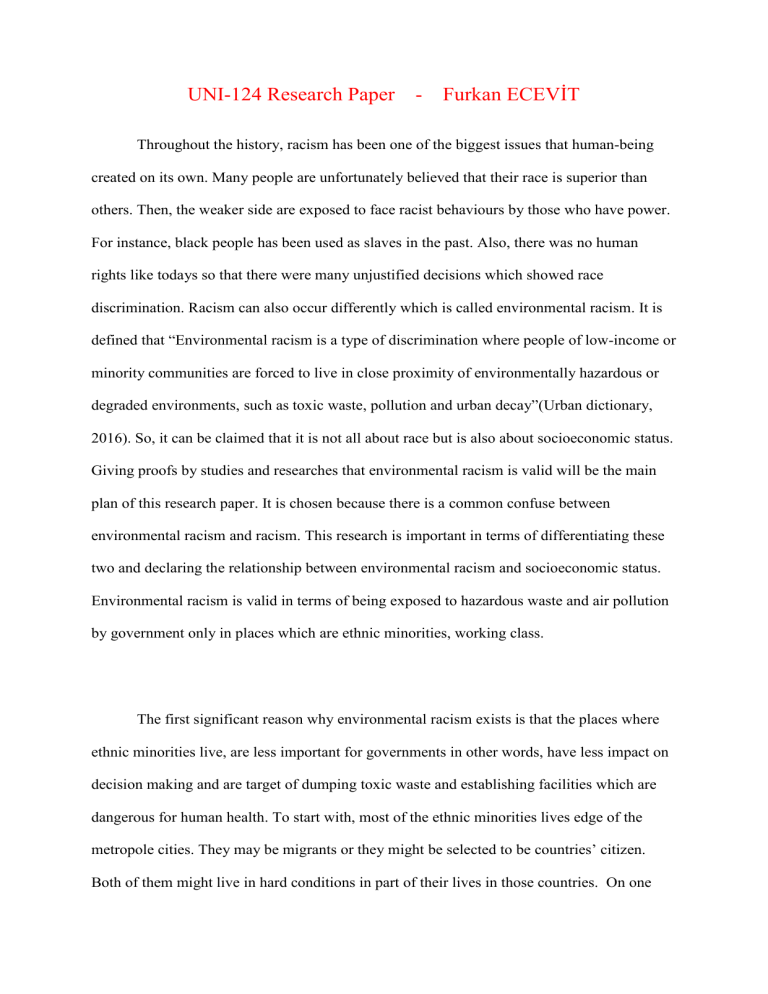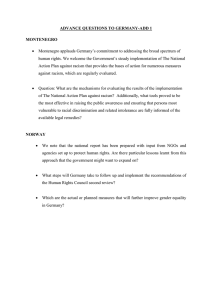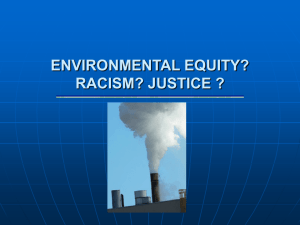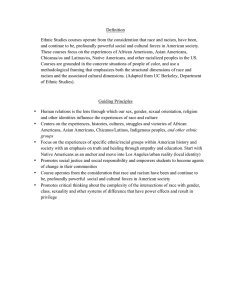
UNI-124 Research Paper - Furkan ECEVİT Throughout the history, racism has been one of the biggest issues that human-being created on its own. Many people are unfortunately believed that their race is superior than others. Then, the weaker side are exposed to face racist behaviours by those who have power. For instance, black people has been used as slaves in the past. Also, there was no human rights like todays so that there were many unjustified decisions which showed race discrimination. Racism can also occur differently which is called environmental racism. It is defined that “Environmental racism is a type of discrimination where people of low-income or minority communities are forced to live in close proximity of environmentally hazardous or degraded environments, such as toxic waste, pollution and urban decay”(Urban dictionary, 2016). So, it can be claimed that it is not all about race but is also about socioeconomic status. Giving proofs by studies and researches that environmental racism is valid will be the main plan of this research paper. It is chosen because there is a common confuse between environmental racism and racism. This research is important in terms of differentiating these two and declaring the relationship between environmental racism and socioeconomic status. Environmental racism is valid in terms of being exposed to hazardous waste and air pollution by government only in places which are ethnic minorities, working class. The first significant reason why environmental racism exists is that the places where ethnic minorities live, are less important for governments in other words, have less impact on decision making and are target of dumping toxic waste and establishing facilities which are dangerous for human health. To start with, most of the ethnic minorities lives edge of the metropole cities. They may be migrants or they might be selected to be countries’ citizen. Both of them might live in hard conditions in part of their lives in those countries. On one hand, they struggle with adaptation problems. On the other hand, due to the fact that they do not have proper legal rights like work permit, they are become a target for dangerous facilities, plants. It occurs because these places have ethnic variety, it is hard to collaborate, communicate each other to protest this situation. So, with all these disadvantageous of these places like not having legal rights and collaborating problems, governments use their initiative in these places to establish plants and to dump toxic waste. As explained in the article “Environmental Racism: The causes, consequences, and commendations”(1991), by using EPA’s study called CERCLIS investigates uncontrolled toxic waste sites in ethnic minority communities in USA and results that the majority of African, Hispanic Americans lived these areas and millions of them still live in places near to the uncontrolled toxic areas(p.161). Another resource which examines that whether there is a relationship between regulatory activity to the plants which have emission problems and ethnic minorities or not. “Plants in areas with large minority populations did have somewhat fewer actions, but these effects were small and generally insignificant.”(Gray, 2010, p.17) So, it can be deduced that there is a strong relationship between government behaviour and ethnic minority places. In addition to this, the same study on regulatory activity examines that “We found plants in areas with high voter turnout also faced more regulatory activity.”(Gray, 2010, p.17). So, it can be analysed that just because migrants or selected people (such as with green card in USA) do not have voting rights, places that have high minority population seem to have less impact on government, and they just do not care about to bring them social services. To conclude, ethnic minorities is one of the fact which proofs the validity of environmental racism. The second essential factor why environmental racism exists is that there is a relation between socioeconomic classes and environmental discrimination. To begin with, people of low-income suffers from where they live because the places they live is generally close to environmentally hazardous environment. Those people are generally from working class and are exposed to more toxic waste and air pollution problems compared to elite class who lives in most beautiful sides in cities. Governments also do not concern those places’ problems at all. “People who are unorganized are not likely to be represented, since the unorganized are often those persons not endowed with the economic and political resources necessary to become organized; regulatory politics thus generally exclude the poor.” (Colquette and Robertson, 1991, p.169). So, it can be analysed that people in those places should collaborate each other in a way, in order to prevent right loss. People in those places might feel excluded. One way to get away from there for those people is to have at least mid-level income job and move away from there to more peaceful, healthy places. Another aspect to the relation between income level and being exposed to hazardous toxic look from completely different perspective. Downey and Hawkins states that “it seems likely that increases in income levels across neighbourhoods and households will be more strongly associated with declining hazard levels in minority neighbourhoods and households than in white neighbourhoods and households.”(2008, p.4). So, it can be analysed that low income level not only affects hazardous toxic but also race issue affects it in the same conditions which is connected to the first claim of this research. Second of all, third world countries like African countries such as Ivory Coast, Nigeria can be considered as poor, working class of the world and they unfortunately had been polluting by developed countries. For example, there was an event in Ivory Coast that developed countries dumped their caustic soda and petroleum residues then caused many people’s lives negatively and because it has continuous harm, people still suffer from it. The main point is because developed countries have power, they always find a way to show it as a normal thing in business. “The key message here is that the dumping of toxic and other waste in the third world countries in not exceptional, but rather is part of the normal "contracted out" disposal process common to global capitalism” (White, 2008-09, p.107). So, it can be generalized the class differentiation (working class-elite class) to the countries which ones are elite and the others are working, poor class. All in all, it can be resulted that working class is related to environmental racism proves the validity of environmental racism. Briefly, ethnic minorities and socioeconomic status of people or countries are two enough facts to demonstrate their relations with environmental racism. Firstly, it is argued that whether places where ethnic minorities live face more hazardous waste or not. At the second, it is discussed to find the answers to the question that do low-income people face more hazardous waste than elite class? So, with all these arguments together in this paper, it is tried to show the existence of environmental racism. The world would be better place if any racism does not exist in my opinion. Reference List Colquette, Michele, K. and Robertson, E. (1991). Environmental Racism: The causes, consequences, and commendations. Tulane Environmental Law Journal 5 (1): 153207. Downey, L., Hawkins, B. (2008). Race, income and environmental inequality in the United States. Social Perspect 51 (4): 759-781. Environmental racism. (2016). In Urban Dictionary. Retrieved from: https://www.urbandictionary.com/define.php?term=environmental%20racism Gray, W., Shadbegian, R.G., Wolverton, A. (2010). Environmental Justice: Do poor and minority populations face more hazards?. Working Paper. 10 (10). White, R. (2008-09). Toxic cities: globalizing the problem of waste. Social Justice. 35(3). 107-119.


